January – 2011
Special Issue: Prior, Experiential and Informal Learning in the Age of Information and Communication Technologies
The Development of an Online Instrument for Prior Learning Assessment and Recognition of Internationally Educated Nurses: A Pilot Study
Elaine Elizabeth Santa Mina, Carol Eifert, Martha Ireland, Carol Fine, Vaska Micevski, Ruth Wojtiuk, and Martha Valderrama
Ryerson University, Canada
Gail Wilson
St. Michael’s Hospital, Canada
Abstract
A fully online prior learning assessment and recognition (PLAR) tool for internationally educated nurses (IENs) was developed and tested by an inter-professional team at Ryerson University. The tool consisted of two stages: a self-assessment component followed by a multiple-choice examination and narrative (vignette) evaluation. The purposes of the study were to describe the demographic profile of the IEN registered nurse (RN), to develop the benchmark responses that demonstrate competency at the entry-to-practice level of the typical IEN RN, and to describe the experience of completing an online PLAR tool. A mixed-method approach was used. Findings demonstrated that IEN RNs who immigrate to Ontario, Canada, are of various ages and come from a wide spectrum of countries. The PLAR process holds promise for an objective assessment of IEN’s eligibility to write the Canadian Registered Nurses Examination (CRNE) and to meet a global need. Further testing of the tool across a broader sample is required.
Keywords: PLAR; internationally educated nurses; online assessment
Background and Context
In 2005, successful nursing degree completion became a regulatory requirement with the College of Nurses of Ontario (CNO) for eligibility to write the Canadian Registered Nurses Examination (CRNE), to attain registration, and to practice as a registered nurse (RN) in Ontario. Additionally, in lieu of a BScN, an equivalent degree from another jurisdiction or an equivalent combination of basic nursing education plus additional education and/or experience may be deemed degree-equivalent by the CNO (2006).
This new requirement poses a challenge to internationally educated nurses (IENs) who seek immigration and registration as RNs in Ontario. IENs must provide evidence to the CNO that their international nursing diploma or degree education and experience meets equivalence to an Ontario baccalaureate nursing degree at the entry-to-practice level. In 2009, there were 3,611 new RN members of the CNO and 9.3% of them were IENs, mainly from the United States, the Philippines, and India (CNO, 2009). According to Blythe and Baumann (2009, p. 192), “the number of IENs resident in Canada is unknown.” IENs are not necessarily coming to Canada to practice, and if they come as family members or through the Live-In Caregiver Program, their nursing qualifications may not be declared.
To assist IENs in demonstrating evidence of degree equivalence, an inter-professional team of researchers from the Daphne Cockwell School of Nursing and the G. Raymond Chang School of Continuing Education at Ryerson University developed and tested a fully online prior learning assessment and recognition (PLAR) tool for IENs. This work responds to the need for objective and transparent assessments to determine equivalence to baccalaureate nursing education in Canada, as per the CNO’s 2006 PLAR Report and Recommendations: A PLAR Model for Nursing Baccalaureate Equivalency.
In 2008, funding from the Ministry of Citizenship and Immigration Ontario supported the team’s development and testing of an online, web-based tool, modeled upon the competencies for entry-level registered nurse practice (CNO, 2007). The team chose to create an online tool in order to meet the need for accessibility to a PLAR process for IENs who may not be geographically located in Toronto, Ontario.
This PLAR tool consists of two stages, which inform IENs of the practice competencies in Ontario and of their status vis-à-vis achievement of degree equivalence. The first stage guides them through a self-assessment of degree equivalence and helps them to ascertain documents that may constitute evidence of degree equivalence. The second stage provides a multiple-choice examination and narrative (vignette) evaluations to objectively assess competency level. The first stage can be completed off-shore, during the immigration process and prior to arrival in Canada, which avoids expensive travel typically associated with prior learning assessments. All elements in the PLAR tool are linked to the national competencies by nursing subject matter experts so that a comprehensive report of competencies and evidences to support learning can be produced. The IEN can submit his/her PLAR report to the CNO for consideration of eligibility to write the CRNE. This tool also helps IENs identify any areas where additional education or work experience might be required by highlighting competencies that had not been met by prior learning.
To ensure that this instrument provides fair, objective assessments of degree equivalence for IENs, the team conducted a study to test its reliability and validity. This study had three purposes: 1) to describe the demographic profile of the IEN RN in Ontario; 2) to develop the benchmark responses that demonstrate competency at the entry-to-practice level of the typical IEN RN; and 3) to describe the experience of completing an online PLAR tool.
Method
The design was a mixed-method, initiation methodology which met the requirement for broad range phenomena and multiple theoretical frameworks to disclose paradoxes (Greene, Caracelli, & Graham, 1989). A combination of quantitative and qualitative approaches facilitated the exposure of congruent, contradictory, and omitted responses considered salient to demonstrate competency at the degree equivalence level.
Three instruments were used: (a) a demographic survey; (b) the PLAR tool, which included the self-assessment inventory of evidences organized by the 104 competency statements and self-ranking from novice to expert (Benner, 1984), a 60-question multiple-choice examination, randomly released from a bank of 172 questions, and eight narrative clinical vignettes and one research vignette; and (c) a post-PLAR satisfaction survey with categorical questions to assess level of difficulty, ease of use, and technical problems with the online instrument. The analyses compare individual and aggregate participant PLAR self-assessment responses to responses expected of an RN at the baccalaureate entry-to-practice level.
The online PLAR tool was created using the entry-to-practice competencies that are organized according to the standards of nursing practice identified by the College of Nurses of Ontario (2007). Prior to the study, the clinical and academic nurse experts on the team mapped each item from the self-assessment inventory, the multiple-choice examination, and the clinical and research vignettes to the 104 competency statements via consensus method.
With input and feedback from faculty experts, the nurse-investigators created a test bank of 172 multiple-choice questions and corresponding answers for the competencies. Each of the questions and corresponding answers were also mapped to respective competencies by the principal investigator. Inter-rater reliability across the investigator team was conducted during data analysis.
For each of the eight clinical vignettes and the research vignette, key competency concepts were identified. Each concept was mapped to the corresponding competency statement. Then the nurse-investigators created the competency-based vignette questions and respective responses to reflect the baccalaureate, entry-to-practice level. Consensus method was used for this entire process.
The following is a sample of one of the clinical vignettes:
You are working the night shift after being hired a month ago as an RN on a busy medical/surgical unit. One of your clients is an 80-year-old man, two days post-operative from a heart valve replacement. You assess his vital signs and observe that he is short of breath with labored respirations. He has had no urine output since your shift began. He appears more confused than when you cared for him previously. You have some ‘give as necessary’ orders from the physician, including giving oxygen and inserting a Foley catheter if necessary.
Here is a sample question for this vignette:
What other assessment findings would be helpful in your decision to initiate oxygen therapy?
The study was conducted between 2008 and 2009. After ethics approval was received from the university, participants were recruited from the CNO mailing list of IEN RNs who had successfully written the CRNE within the previous two years and had consented to be contacted for research purposes. This sample was chosen as a representative of entry-to-practice IEN RNs in order to develop benchmark, degree-equivalent responses for the 104 competencies.
A convenience sampling design was used in this study. The possible sample size was 198. Sixteen did not meet study criteria, therefore N was 182 (Table 1). Study participants received CDN$250.00 upon completion of the entire tool or a CDN$10.00 certificate for a popular coffee shop for partial completion. Only nine of the 51 participants completed the entire PLAR tool. The main reason for attrition rates was the length of time needed for completion as the tool was available for intermittent access over a three-month period.
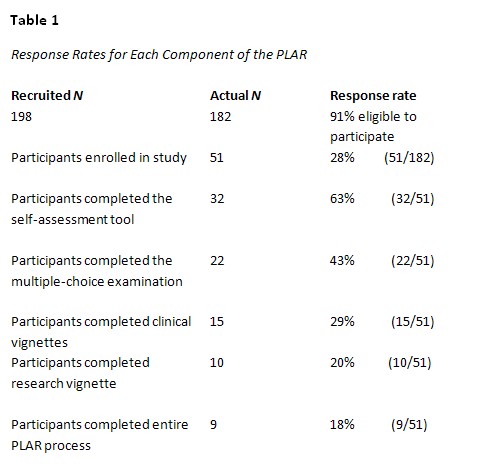
Data Analysis
The investigators mapped the quantitative and qualitative data to all 104 competencies pre- and post-study. At the individual level of analysis (n = 9), data were triangulated for each competency and demonstrated convergence, divergence, and omission of evidence for degree equivalence. The sample size of participants who completed the entire PLAR was inadequate (n = 9) for determining benchmarks for 104 competency statements. Therefore, data analysis emphasis was at the aggregate level. Aggregate frequency counts were calculated for the self-assessed proficiency levels and types of evidences per competency. For the multiple-choice examination, investigators compiled descriptive statistics as well as psychometric testing. Then, by consensus, they conducted thematic analysis of each of the vignette responses. Codes were analyzed against the predetermined key words per competency per vignette for congruence, divergence, and omission of evidence. For the post-PLAR satisfaction survey, frequency counts were calculated per question.
Outcomes
The demographic findings are shown in Table 2.
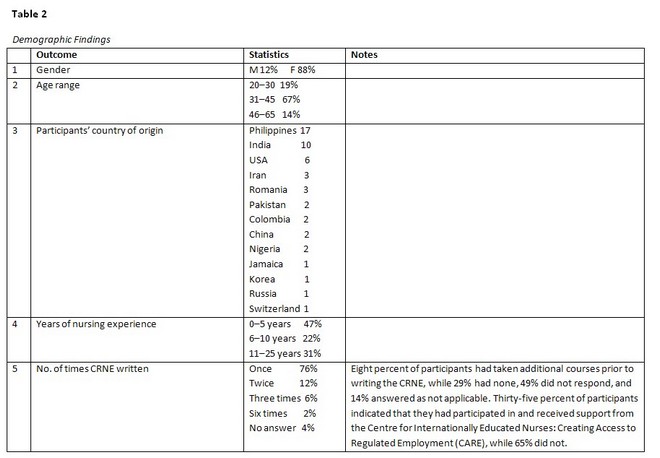
In the self-assessment the overwhelming majority of participants self-rated as competent or proficient on 104 competencies across the five standards (Figure 1). The most frequent evidence types cited across all competencies were diploma/degree and performance appraisal.
The complex process of descriptive analysis, psychometric testing of the multiple-choice examination, thematic coding of narrative responses, and remapping of all measures to the 104 competencies revealed strengths and gaps in instrument capacity to measure degree equivalence for each competency statement.
The aggregate results of the multiple-choice examination indicated results that were comparable to a university passing grade (M = 64.15, SD = 8.47). Psychometric testing revealed that questions with an item difficulty of less than 0.3 may require rewording. Investigator inter-rater reliability on mapping examination questions to competency statements ranged from .1 to 1.0. A score of less than 0.6 is inadequate and questions are flagged for rewording in future studies. Coding analysis revealed some convergence, divergence, and omission at the individual level of analysis; however, data saturation was not reached. The consensus method demonstrated confirmability; however, findings were inconclusive due to a small sample size and variation in questions per vignette.
Most participants found the experience challenging, and yet rewarding (Figure 2). They generally found the examination and learning experience enjoyable (Figure 3). The majority found it easy to use (Figure 4) and had no technical difficulties (Figure 5).
Conclusion
IEN RNs who immigrate to Ontario cross the spectrum of countries and ages. This PLAR process holds promise for an objective assessment of IEN’s eligibility to write the CRNE and thereby meet a global need for the assessment and recognition of international professional credentialing in nursing. Implications for future research include an increase in indicators by which to measure all 104 competencies. This complex methodology to map triangulated quantitative and qualitative data to 104 competency statements requires large sample sizes. Subsequent methodological refinement is required to triangulate data findings, per competency, and thereby develop reliable and valid benchmarks for each. Replication studies with sample demographics that reflect the Canadian mosaic of IENs are required to create generalizable benchmarks for degree equivalence for ultimate assessment and recognition of credentials for registration purposes.
Technology may help bridge the geographic and professional chasms before professionals plan emigration as online tools are quite accessible and easy to use, as demonstrated by this study. Off-shore and pre-migration access may inform international professionals of Canadian credentialing requirements for entering the Ontario workforce. An online instrument can guide candidates through the creation of a portfolio with evidence to support their self-appraisal and thereby provide a more realistic picture of expectations. An IEN online PLAR process may be expanded to include other disciplines and professions so that they too may benefit from its accessibility and financial affordability.

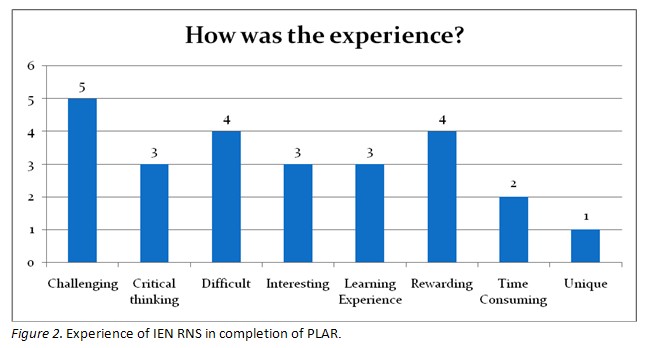
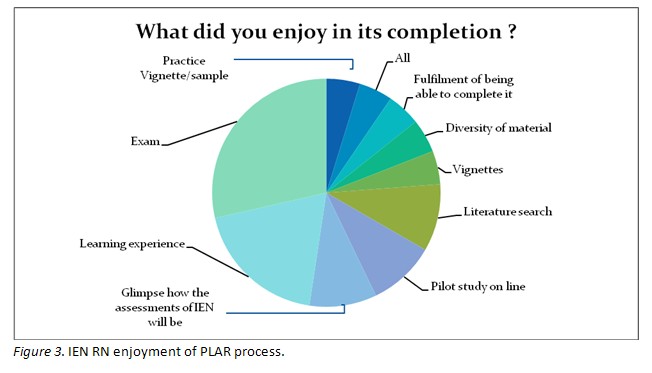
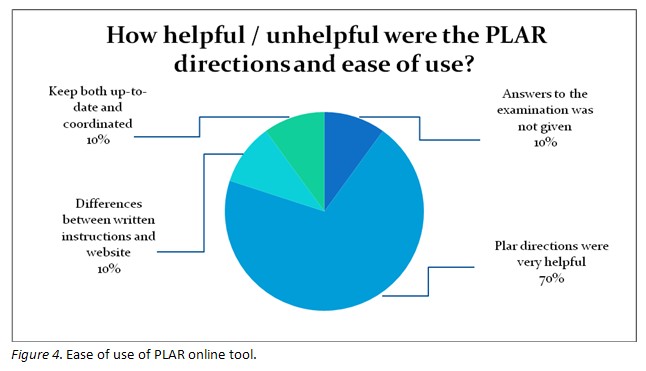

References
Benner, P. (1984). From novice to expert: Excellence and power in clinical practice. American Journal of Nursing, 84(12), 1480.
Blythe, J., & Baumann, A. (2009). Internationally educated nurses: profiling workforce diversity. International Nursing Review, 56, 191–197.
College of Nurses of Ontario. (2006). A Prior Learning Assessment and Recognition (PLAR) model for nursing baccalaureate equivalency. Prepared for the College of Nurses of Ontario by the Canadian Institute for Recognizing Learning (CIRL) January 20, 2006.
College of Nurses of Ontario. (2007). Entry-to-practice competencies for Ontario registered nurses as of September 2007.
College of Nurses of Ontario. (2009). Trends in general new members class 2009.
Day, M. (2001). Development of benchmarks for prior learning assessment Part 1: Research. Nursing Standard, 15(34), 37–44.
Greene, J.C, Caracelli, V. J., & Graham, W.F. (1989). Toward a conceptual framework for mixed-method evaluation designs. Educational Evaluation and Policy Analysis, 11, 255–274.
PID: http://hdl.handle.net/10515/sy5gh9bp3
